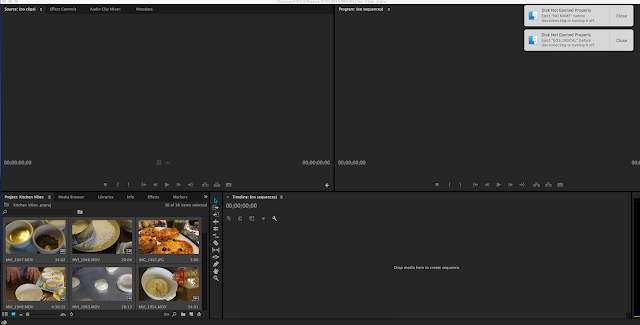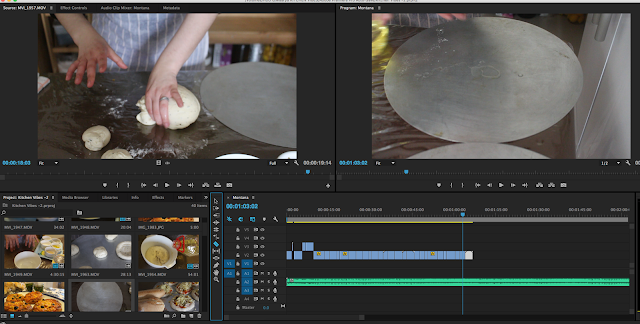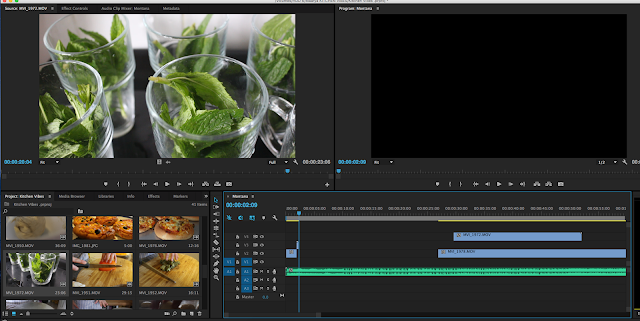Unit27:FactualPogramming Maarya
Tuesday, 13 June 2017
Monday, 12 June 2017
Feedback
https://drive.google.com/file/d/0B1-jPiPTccLJWFB3dHkxenA2VEE/view?usp=sharing
After we showed our documentary, we asked the audience a few questions. Such as What style did they think it fit and why, How they found it and what stood out to them.
Their feedback was important to us so we could learn how they received our media
After we showed our documentary, we asked the audience a few questions. Such as What style did they think it fit and why, How they found it and what stood out to them.
Their feedback was important to us so we could learn how they received our media
- Do you feel it fit a format of Documentary (Factual Programming), if so which one?
- 'Does the name suit?
- What would you change about it?
Thursday, 25 May 2017
Screenshots of editing
 Firstly i opened up the editing software which was Premier Pro and then imported all the following clips from my camera on to the software. As i gathered all the footage i went over them to see what clips i wanted in my time line and what clips i didnt want.
Firstly i opened up the editing software which was Premier Pro and then imported all the following clips from my camera on to the software. As i gathered all the footage i went over them to see what clips i wanted in my time line and what clips i didnt want.There were a few clips I had deleted because they were just test trials for when I was filming.

When dragging my chosen clips in to the timeline i started to form a sequence and then i used the cutting tool to cut any excess bits from the clip. I also used a technique called cutting to the beat.

I then converted the song from YouTube which i was using for my video and then placed it in the timeline where i started to also drag clips on to the timeline.

I started putting all the clips on the timeline forming a sequence, i edited certain clips to speed up the duration and also add some effects such as fades.
All of my footage and Premier Pro editing is saved in a folder under the title 'Kitchen Vibes'.
After editing i exported the finished music video.
Friday, 19 May 2017
Wednesday, 10 May 2017
Wednesday, 26 April 2017
Task 1B Draft
For
task 1B I will be writing up an analysis a Documentary and two other factual
programmes of my choice; giving a detailed report of the codes and conventions
utilised. Lastly I will be conducting an analysis of the codes and conventions
of a news broadcast.
Documentary- Britain's Crimes of Honour
The
documentary was broadcasted on BBC one Panorama and is based on the crimes in
Britain which are going unreported, this being the beatings, imprisonment and
even murder committed by those closest to the victims, and their families.
These are crimes of so called 'honour'. This type of documentary is expository and
utilises typical conventions such as narration, Interviews and conventional
narrative structures.
For example
there is narration (voice of God), which is used to directly address the
viewer, giving an explanation between the footage and voice over. The narration
is a direct relationship between what we see in the documentary and what we
hear in the voice over. The documentary is carried out in a conventional
narrative format with all the scenes in chronological order.
The narrator
is also a reporter in the documentary, she plays a main role conducting
interviews and visiting the places of where the crimes were committed, and
these interviews help support the argument of the documentary.
The genre of
this programme is combined with reality television and educational, as the
documentary presents a sense of the reality that lives in the UK within Asian
society’s and this educates the audience on the realism of the attacks carried
out. The programme displays the photographs of the victims before and after
these attacks had occurred, this gives the audience a sense of the realism
which occurs within these communities and their backwards traditions.
Also with
access to police
investigations, Panorama reveals the outrageous details of 'honour' killings,
of women who were driven to suicide and those on the run, in fear of their
lives. These were essential to include in the documentary as it represents the
accuracy showing that this was not false information in fact true to life.
During the
documentary it mentions a national helpline that is used to contact for
domestic violence, there are statistics shown on how many people have called in
a year, this also represents the quality of facts used to prove accuracy during
the documentary.
Documentary- Walking the Americas
Walking the
Americas is a travel documentary featuring Levison Wood, an explorer and writer
who begins his trip from the north-eastern tip of Mexico, and continues his
walk across the entire length of Central America, through eight countries. This
programme was broadcasted on Channel 4 and was continuous every week showcasing
four episodes.
This programme
is combined with three different documentary formats; Expository, Interactive
and Performative. There is narration (voice of god) by the same reporter which
is edited in to the documentary addressing the viewers of what they are seeing.
For example there is an establishing shot taken by a drone camera; showing the
viewer the setting of where the walk is taking place, along with this is the
narration addressing the relationship between what the viewers can see and where
they are.
There are
elements of interactive techniques which are used such as the acknowledgement
of the camera and crew but also the film-maker who is speaking directly to his
subjects for example, whilst Levison walks past villages and towns there are
people who he bumps in to that have something to say to the camera. This is also a representation of different
viewpoints where these people contribute different information about their
town/village.
This travel
documentary is performative as the filmmaker stars in his own film, he is given
camera equipment to film his journey. In one of the episodes it shows the process
of the filmmaker making the film, this is shown by his partner on the journey
giving the viewers a sense of how the film is made, this is known as
self-reflexive.
Another
example of how this documentary is performative is the filmmaker uses a handheld camera throughout the journey; giving the audience a sense of his personality
and views, this is also portrayed through conducting interviews with local
people within the town and giving his opinion about it.
The purpose
of the travel documentary is to educate and entertain the viewers of the
countries landmarks and cultures which Levison Wood explores. During the
episodes he explores the different towns in which gang violence and drugs are
well known, this gives the audience a sense of the realism that lives within
those countries, towns or places.
I also saw
in one episode where Levison crosses the border and comes across a refugee camp
that lives in terrible conditions, this portrayed awareness to the viewers of
what the sad reality is of those refugees trying to look for work but are stuck
in those camps. This was a representation of the way things are for them and demonstrations
the accuracy in the documentary showing the true to life.
The episodes
were made into the form of a narrative structure throughout the documentary.
For example the episodes consisted of the journey moving forward giving us a
sense of the explorer’s story from where he began his journey. This was an effective way of addressing the
audience and telling them the narrative of the documentary.
Documentary- Planet Earth II
Planet Earth
II is a 2016 multinational nature documentary series produced by the BBC as a
sequel to Planet Earth, which was broadcast in 2006. This programme is an
example of an expository documentary as it relies on verbal commentary to give
us a direct relationship of the footage and voice over; explaining what we are
seeing.
The audience
for this type of documentary listens to the narrator (David Attenborough) who’s
voiceover emphasis what is happening with argumentative logic. For example
during each episode there would be footage captured of the wildlife in
different parts of the world and as that footage is being displayed; David
Attenborough narrates and explains what is happening.
Planet Earth
enables us as an audience to see the realism of the wildlife animals and how
they survive around the world in magnificent places. The footage almost looks
fake however the filmmakers have gone to the extreme; using brilliant cameras
and perfect timing to film this footage. During the episodes, there are many shots
and angles which give us different views for example the establishing shot which
is used quite often captures the action of the lions attacking a giraffe, this
scene gives the viewer an intense feeling, particularly with the sound and
narration from David Attenborough.
The use of
narrativisation is a key factor within this documentary as David Attenborough
narrates the story of the animals; telling the audience the life of each animal
that lives within that specific area of the world. The narrativisation gives an
intense feeling, for example during an episode there was a particular scene
where snakes were hunting for prey and this scene was made more intense with
the use of sound along with David Attenborough’s voice which caused a lot of
suspense towards the viewer.
Throughout
this documentary realism is portrayed, for example the animals which live in their
natural habitats are shown taking measures that need to be essential in order
for them to survive. Another example was shown clearly through the episode
which consisted of male penguins in the North Pole trying to provide food for their
family; showing the dangerous practices that are essential for them to take.
News Broadcast- Al Jazeera
The news
broadcast that I’m analysing is an extract from “Al Jazeera News”, which covers
different types of stories. During the broadcast there are studio news readers
who are the main reporters/presenters that appear on TV conducting an in depth
research to identify and develop news stories of interest.
The
presenters edit copy from other reporters or external news agencies, and also
write news bulletins, links and assist in the production of scripts. Whilst
watching this broadcast I was not able to see all the pre-production
documentations of the presenter, however the presenter did hold papers in her
hand which she occasionally looked at.
News readers
need to have certain skills and attributes, these are having knowledge of
editorial, having good interpersonal skills, good communication skills and also
to have a key understanding of the legal and ethical issues which affect
journalism. During this news broadcast I was able to clearly understand what
news story the reporter was addressing. The presenter had good, interpersonal
and communication skills and I was able to identify the five W’s of the
particular story.
It is
essential for the visual codes to be put in practice when watching the reporter
and how they should be presented towards the viewers. The reporter looked
professional and was elegant in her appearance; her hair was neat.
There are
contributors that appear in news broadcasts, these are usually experts,
witnesses or members of the public. During Al Jazeera’s broadcast there was a
news story which consisted of an attack in Sudan, along with this were eye
witnesses who appeared on TV giving information of what happened. These
contributors impact the broadcast as it strengthens the news report.
The report
structure is set out in a conventional way; compromising the same techniques. This
is applied with the piece to camera then cut away, interview, voice of the
people and lastly graphics.
Tuesday, 25 April 2017
Recce
Subscribe to:
Comments (Atom)

















